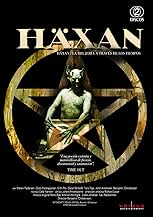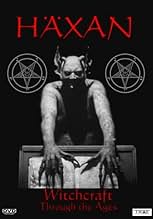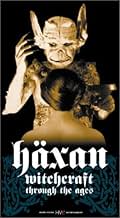IMDb RATING
7.6/10
18K
YOUR RATING
Fictionalized documentary showing the evolution of witchcraft, from its pagan roots to its confusion with hysteria in Eastern Europe.Fictionalized documentary showing the evolution of witchcraft, from its pagan roots to its confusion with hysteria in Eastern Europe.Fictionalized documentary showing the evolution of witchcraft, from its pagan roots to its confusion with hysteria in Eastern Europe.
- Director
- Writer
- Stars
Elisabeth Christensen
- En ældre bondekone
- (as Elizabeth Christensen)
- …
John Andersen
- Chief Inquisitor
- (as Johs Andersen)
Emmy Schønfeld
- Marie, the Seamstress
- (as Emmy Schönfeld)
- Director
- Writer
- All cast & crew
- Production, box office & more at IMDbPro
Featured reviews
This film gives us a thoughtful look at the horrifying potential of fear, ignorance and superstition. I have to say I admire the courage Benjamin Christensen showed in making this film which not only must have offended the sensibilities of the time for the obvious reasons but also because it dared to champion reason over superstition as a way of explaining things which we do not fully understand. This film resonates with its message that those who judged others unjust may not have been just themselves.
I found this 1922 "documentary" to be amazing in it's inovative and creative portrayal of witchcraft in the middle ages. Scenes of nudity and torture made this film very controversial in 1922 and caused it to be banned as well as greatly edited in later versions. Criterion has done a great job of preserving the film as it was intended to be seen with censored footage restored, an excellent tinted print, a corrected "projection" speed, a new score that recreates the music played at the original Danish premiere, and some interesting extras. The 1968 William Burroughs narrarated version is also included here and it's pretty ridiculous. The jazz soundtrack is just so very wrong. But still, it's interesting to see, kind of like the "Love Conquers All" version of Brazil. I think that anyone who is interested in film and film history will find this dvd facinating.
The writer and director Benjamin Christensen discloses a historical view of the witches through the seven parts of this silent movie.
In the beginning, there is a slide-show alternating intertitles with drawings and paintings to illustrate the explanations of the behavior of pagan cultures and in the Middle Ages regarding their vision of demons and witches.
Then there is a dramatization of the situation of the witches in the Middle Ages, with the witchcraft and the witch-hunts.
Finally Benjamin Christensen compares the behavior of hysteria of the modern women of 1921 with the behavior of the witches in the Middle Ages, concluding that they are very similar.
"Häxan" is incredibly perfect for a for a 1922 movie. Like in a thesis, he exposes his point of view based in his study of the theme along the time. The reconstitution of the witches in the Middle Ages is amazing. The last part with the comparison with the hysteric women is funny in 2010, but it was the reality in 1921. My vote is eight.
Title (Brazil): "Häxan - A Feitiçaria Através dos Tempos" ("Häxan - The Witchcraft Through the Time")
Note: On 16 Aug 2018 I saw this film again.
In the beginning, there is a slide-show alternating intertitles with drawings and paintings to illustrate the explanations of the behavior of pagan cultures and in the Middle Ages regarding their vision of demons and witches.
Then there is a dramatization of the situation of the witches in the Middle Ages, with the witchcraft and the witch-hunts.
Finally Benjamin Christensen compares the behavior of hysteria of the modern women of 1921 with the behavior of the witches in the Middle Ages, concluding that they are very similar.
"Häxan" is incredibly perfect for a for a 1922 movie. Like in a thesis, he exposes his point of view based in his study of the theme along the time. The reconstitution of the witches in the Middle Ages is amazing. The last part with the comparison with the hysteric women is funny in 2010, but it was the reality in 1921. My vote is eight.
Title (Brazil): "Häxan - A Feitiçaria Através dos Tempos" ("Häxan - The Witchcraft Through the Time")
Note: On 16 Aug 2018 I saw this film again.
The striking visuals would in themselves be sufficient reason to watch "Häxan", but in addition it is a thought-provoking feature that combines dark humor, some occasional chilling moments, and perceptive commentary on human nature. It's an unusual package and an unusual feature, and there aren't many films quite like it.
Simply on the surface, the series of unusual visuals and believable recreations of bygone eras would make for interesting viewing. Benjamin Christensen added a strong dose of the macabre to practically every scene, even in some of the smaller details that are only noticeable upon repeat viewings. Some of it is fascinating, some of it unsettling, all of it interesting.
But there is much more to "Häxan" than a mere collection of grotesque images and vignettes. Towards the end, in particular, the commentary becomes quite pointed. It is quite easy for anyone - film-maker, writer, commentator - to criticize and condemn the beliefs and practices of the Middle Ages or of any other long past era. But it is far more of a challenge to, as Christensen has done here, point out the sometimes devastating parallels to one's own era. It is always such a comforting fiction to believe that we are so much more enlightened than past generations have been, and yet it is rarely if ever true.
Christensen aptly illustrates the point that the inability to deal with the odd, the eccentric, and the unusual in our fellow beings is a perennial failing of humanity. Each generation simply devises its own means of stigmatizing and punishing those who cannot conform. (Nor is our own generation markedly better than was Christensen's.) This feature can certainly be viewed (either in the original silent version, or in the 1960s version with some spoken narration) for entertainment value alone. But it is even more pertinent in its observations on human nature. It's an often unsettling movie, with some images that might be bit too uncomfortable for some viewers. But for all that, it's an unusual and worthwhile viewing experience.
Simply on the surface, the series of unusual visuals and believable recreations of bygone eras would make for interesting viewing. Benjamin Christensen added a strong dose of the macabre to practically every scene, even in some of the smaller details that are only noticeable upon repeat viewings. Some of it is fascinating, some of it unsettling, all of it interesting.
But there is much more to "Häxan" than a mere collection of grotesque images and vignettes. Towards the end, in particular, the commentary becomes quite pointed. It is quite easy for anyone - film-maker, writer, commentator - to criticize and condemn the beliefs and practices of the Middle Ages or of any other long past era. But it is far more of a challenge to, as Christensen has done here, point out the sometimes devastating parallels to one's own era. It is always such a comforting fiction to believe that we are so much more enlightened than past generations have been, and yet it is rarely if ever true.
Christensen aptly illustrates the point that the inability to deal with the odd, the eccentric, and the unusual in our fellow beings is a perennial failing of humanity. Each generation simply devises its own means of stigmatizing and punishing those who cannot conform. (Nor is our own generation markedly better than was Christensen's.) This feature can certainly be viewed (either in the original silent version, or in the 1960s version with some spoken narration) for entertainment value alone. But it is even more pertinent in its observations on human nature. It's an often unsettling movie, with some images that might be bit too uncomfortable for some viewers. But for all that, it's an unusual and worthwhile viewing experience.
10MrETrain
More commonly known as "Witchcraft Through the Ages", this is definitely one of the most bizarre, visually arresting movies of all time, even nearly 80 years later. It starts out as a rather dry documentary, detailing medieval superstitions and folklore while showing ancient woodcarvings of witches and demons in various forms. Then we move on into the dramatic portion of the film. In one scene we see witches concocting potions using the body parts of corpses from the gallows. One witch walks in carrying a bundle of sticks, and undoes the bundle revealing a decomposed human hand hidden inside. Fans of "The Blair Witch Project" should take notice, especially considering that the Danish title of this film is "Haxan", also the name of the movie company that created "Blair Witch".
Director Benjamin Christensen appears as a leering, tongue-wagging Satan, with very realistic makeup. The witches are shown with the Devil and his minions performing various acts of sacrilege and perversion that must have been extremely shocking at the time the movie originally appeared, and would be offensive to many people still. The film was banned for many years because of the depiction of these acts (not to mention the occasional nudity), as well as sacrileges performed by nuns and monks. There are some stop-motion animation sequences (pre-Harryhousen, no less) that are very good, especially for the time. This is a difficult movie to describe. It really is something that you'd have to see for yourself.
The version I am reviewing is actually the re-issue from 1966, with a dubbed-over narration by beat novelist/junkie William Burroughs, and a modern, jazzy score featuring Jean-Luc Ponty. I enjoyed Burroughs' narration quite a bit, but oftimes the music is annoyingly inappropriate. Sometimes it works very well, but most of the time I was wishing for a standard orchestral, or vitaphone, score. A Klezmer score, even, would have been very effective. There are a few different versions available, some with subtitles and an orchestral score. Maybe one of these days they'll come out with a version featuring the Burroughs narration along with a more appropriate orchestral score. That would be perfect. As it is, this an impressive, compulsively watchable film that still goes further than most dare to go, even in these much more permissive times.
Director Benjamin Christensen appears as a leering, tongue-wagging Satan, with very realistic makeup. The witches are shown with the Devil and his minions performing various acts of sacrilege and perversion that must have been extremely shocking at the time the movie originally appeared, and would be offensive to many people still. The film was banned for many years because of the depiction of these acts (not to mention the occasional nudity), as well as sacrileges performed by nuns and monks. There are some stop-motion animation sequences (pre-Harryhousen, no less) that are very good, especially for the time. This is a difficult movie to describe. It really is something that you'd have to see for yourself.
The version I am reviewing is actually the re-issue from 1966, with a dubbed-over narration by beat novelist/junkie William Burroughs, and a modern, jazzy score featuring Jean-Luc Ponty. I enjoyed Burroughs' narration quite a bit, but oftimes the music is annoyingly inappropriate. Sometimes it works very well, but most of the time I was wishing for a standard orchestral, or vitaphone, score. A Klezmer score, even, would have been very effective. There are a few different versions available, some with subtitles and an orchestral score. Maybe one of these days they'll come out with a version featuring the Burroughs narration along with a more appropriate orchestral score. That would be perfect. As it is, this an impressive, compulsively watchable film that still goes further than most dare to go, even in these much more permissive times.
Did you know
- TriviaThe Swedish film censors required numerous cuts in the film, before authorizing its release. Among the censored scenes were the closeup of the finger being removed from the hanged man's hand, the trampling of the cross in the witch's sabbath scene, the shot of the oozing infant held over a cooking pot, a closeup of a woman's face while she is on a torture rack, closeups of several instruments of torture being employed, and a shot of a demon embracing a nude woman (all these shots have since been restored to the film).
- GoofsThe skeletal horse-like creature wandering around during the Sabbath clearly is being moved about by a couple of stage hands, hidden under the blanket that covers its "body". The feet of the crew member at the front of the monster are visible in one shot.
- Quotes
Title Card: Poor little hysterical witch! In the middle ages you were in conflict with the church. Now it is with the law.
- Crazy creditsDirector Benjamin Christensen personally thanks his cinematographer and art director through the opening titles.
- Alternate versionsWitchcraft Through the Ages (1968), the 76-minute version of Häxan, narrated by William S. Burroughs, with a soundtrack featuring Jean-Luc Ponty
- ConnectionsEdited into From Camille to Joan of Arc (1961)
Details
- Release date
- Countries of origin
- Languages
- Also known as
- Häxan: Witchcraft Through the Ages
- Filming locations
- Production companies
- See more company credits at IMDbPro
Box office
- Budget
- SEK 2,000,000 (estimated)
Contribute to this page
Suggest an edit or add missing content

Top Gap
What is the Japanese language plot outline for La Sorcellerie à travers les âges (1922)?
Answer
![Watch Trailer [OV]](https://m.media-amazon.com/images/M/MV5BNWUzNDFkOTAtYTdiZi00M2RiLWJiMjktZmZjM2RkNzNhMzBiXkEyXkFqcGdeQXRyYW5zY29kZS13b3JrZmxvdw@@._V1_QL75_UX500_CR0)




























